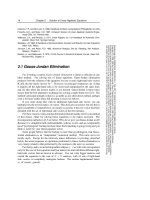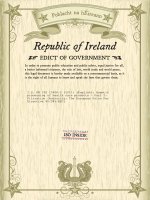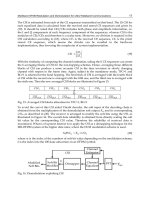problems features of non literal english part 2
Bạn đang xem bản rút gọn của tài liệu. Xem và tải ngay bản đầy đủ của tài liệu tại đây (478.1 KB, 3 trang )
Talk a Lot
Problems
Features of Non-Literal English – Part 2
1. PUNS
A pun is a kind of joke that is based around a word or phrase which has two meanings: one which is
natural in the sentence, and one which is relevant to what you are talking about.
Example:
[Somebody is making bread in the kitchen. You go up to them and ask:]
“Do you need any help?”
[You stress the word “need” because it is a pun on the word “knead”, which is an action in the breadmaking process. “Knead” and “need” are homophones – words that sound exactly the same but which
have different meanings and different spellings.]
When:
For fun! When you want to brighten up your spoken English; to make somebody smile or laugh – or
groan, because your joke is so corny [old and too obvious].
2. PHRASAL VERBS
See Unit 1: Hotel – Features of Non-Literal English – Part 1
3. NON-STANDARD GRAMMAR
Non-standard grammar is a grammatical form that, although incorrect, is often used on purpose in place
of the correct form by a person who knows what the correct form should be.
Example:
[You phone your friend and leave a voice message:]
“Y’alright mate? You comin’ down town later, or what, innit?”
[Translation: “Y’alright, mate?” = “Hello” or “Are you alright, my friend?”; “You comin’ down town later” =
“Are you coming down to the town later?”; “or what, innit?” = speech markers (see Unit 1: Hotel –
Features of Non-Literal English – Part 1). These phrases are simply a form of verbal punctuation and
have no real meaning in the sentence, apart from perhaps reinforcing the question.]
When:
When you want to show that you belong to a particular group, or class of people, who all speak in the
same way – as a means of fitting in. When you don’t want to appear too “posh”, or middle-class, or too
highly educated.
For more fun worksheets, games, and quizzes log onto www.englishbanana.com now!
37
Talk a Lot
Problems
4. CULTURAL REFERENCES
A cultural reference is a word, phrase, or saying that has entered popular culture, e.g. a song, reference
to or dialogue from a film or TV programme, an advert, a catchphrase (e.g. by a comedian), or any other
memorable phrase that has been featured in the media.
Example:
“Hayley! Are you responsible for breaking that window?”
“Yeah… but, no… but, yeah… but no…” [her evasive and rather cheeky reply copies a well-known
catchphrase from the popular BBC comedy series Little Britain.]
When:
When you want to show that you are aware of and a part of the general national popular culture that
extends beyond your home town.
5. IDIOMS
See Unit 1: Hotel – Features of Non-Literal English – Part 1
6. POLITICALLY CORRECT (PC) LANGUAGE
Politically correct language (known as PC language) consists of polite words and phrases that are used
to replace potentially derogatory or insulting language, so that we can talk about something negative or
controversial without causing offence. There are two kinds of politically correct language:
1. Extreme Politically Correct Language: phrases that we don’t use very often in everyday life,
because they seem too extreme or sound silly.
Example:
“My little Billy isn’t fat, he’s just big-boned.” The aim is to try to see something positive in something
negative. But taken to extremes, political correctness can become a bit of a joke, and can lead people to
exclaim in frustration: “It’s political correctness gone mad!”
2. Everyday Politically Correct Language: phrases that we do need to use in everyday life, to avoid
offending or stigmatising other people, especially people who belong to minority groups.
Example:
“We’re planning a special lunch for senior citizens next week.” [Not for old people.] More respectful or
neutral phrases replace blunter, more potentially insensitive, offensive, or alienating language.
Politicians, for example, are keen to use inclusive PC language, which comes across as inclusive to as
many people as possible. Another example of required politically correct language is the use of genderneutral terms, e.g. “police officer” rather than “policeman”, to reflect changes in our workforce and
culture.
When:
When you don’t want to cause offense to anybody who belongs to a minority group. Or when you want
to draw attention to something in a humorous or ironic way, e.g. “Tom hasn’t gone a big nose. No. He’s
just a bit nasally challenged!”
Note: a related non-literal form is Euphemism.
For more fun worksheets, games, and quizzes log onto www.englishbanana.com now!
38
Talk a Lot
Problems
7. HINTS
A hint is an indirect reference to an object or situation. The speaker hopes that the person listening will
understand what they mean, without them having to mention it directly. However, it is not guaranteed
that the listener will understand and therefore “get the hint”.
Example:
[A young couple in love are passing a jeweller’s shop window. She says:]
“Oh, what a beautiful ring! Do you like it?”
[She means: “When are you going to ask me to marry you?”]
When:
When you want to say something or ask for something indirectly – in a subtle way. In the example, the
woman hopes that her partner will “read her mind” regarding getting married, after which she can
pretend that he thought of proposing without having to be asked or reminded. She can therefore tell
herself that her beloved is more thoughtful and sensitive than he really is – and that she is really lucky to
be with him!
8. SLANG
Slang is informal language consisting of words and phrases that replace standard dictionary words and
phrases. It is used far more often in spoken English than in written English. Slang words are known and
used by members of a particular group of people, which might be based on: class, race, gender, age,
education, interests, job, etc.
Example:
“Do you like my new t-shirt?”
“Yeah, man!” [“Yes, my friend.”] “It’s totally sick!” [“It’s really nice!”]
When:
When you want to show that you belong to a particular group. By adopting their slang and customs you
will feel closer to them, and they will be more likely to accept you as a legitimate member of their group.
9. CATCHPHRASES
A catchphrase is a phrase that is repeated often by somebody, particularly somebody famous, usually
for comic effect so that it becomes associated with them through repetition. It may not be very funny if
said only once, but by being repeated often it can become amusing, or annoying – or both.
Example:
“You wouldn’t let it lie!” [In the early ’90s, surreal British comedian Vic Reeves introduced this
catchphrase via his late night cult TV show, which became very popular among students, and is now
always associated with him. To let something lie = to stop talking about a particular thing.]
When:
When you want to build an audience of initiates who feel part of your imaginative world because they
are “in on the joke” (your catchphrases), as opposed to other people who don’t know them.
Catchphrases can also be in-jokes, that enable your followers to feel that they belong to your “gang”.
See also: Cultural References, above.
For more fun worksheets, games, and quizzes log onto www.englishbanana.com now!
39









